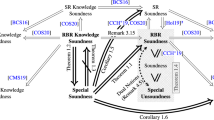Abstract
Oracle constructions have long been used to provide evidence that certain questions in complexity theory cannot be resolved using the usual techniques of simulation and diagonalization. However, the existence of nonrelativizing proof techniques seems to call this practice into question. This paper reviews the status of nonrelativizing proof techniques, and argues that many oracle constructions still yield valuable information about problems in complexity theory.
Supported in part by National Science Foundation Grants CCR-8810467 and CCR-9000045 and by a grant from the International Information Science Foundation.
Preview
Unable to display preview. Download preview PDF.
Similar content being viewed by others
References
D. Angluin, 1980 On relativizing auxiliary pushdown machines, Math. Systems Theory 13, 283–299.
E. Allender, R. Beigel, U. Hertrampf, and S. Homer, 1990 A note on the almost-everywhere hierarchy for nondeterministic time, Proc. 7th Symposium on Theoretical Aspects of Computer Science, Lecture Notes in Computer Science 415, pp. 1–11.
E. Allender and V. Gore, On strong separations from AC 0, submitted.
E. Allender and K. W. Wagner, 1990 Counting hierarchies: polynomial time and constant depth circuits, guest authors of The Structural Complexity Column (ed. Juris Hartmanis), EATCS Bulletin 40, pp. 182–194.
E. Allender and C. Wilson, Width-bounded reducibility and binary search over complexity classes, Proc. 5th Annual IEEE Structure in Complexity Theory Conference, 1990.
L. Babai and L. Fortnow, A characterization of P by straight line programs of polynomials, with applications to interactive proofs and Toda's theorem, Technical Report 90-02, University of Chicago.
L. Babai, L. Fortnow, and C. Lund, Non-deterministic exponential time has two-prover interactive protocols, manuscript.
T. Baker, J. Gill, and R. Solovay, 1975 Relativizations of the P=?NP question, SIAM J. Comput. 4, 431–442.
J. Buss, A theory of oracle machines, Proc. 2nd IEEE Structure in Complexity Theory Conference, pp. 175–181.
J. Buss, 1988 Relativized alternation and space-bounded computation, J. Comput. and System Sci. 36, 351–378.
S. Cook, The complexity of theorem proving procedures, Proc. 3rd Annual ACM Symposium on Theory of Computing, pp. 151–158.
R. Downey, W. Gasarch, S. Homer, and M. Moses, On honest polynomial reductions, relativizations, and P=NP, Proc. 4th IEEE Structure in Complexity Theory Conference, pp. 196–207.
L. Fortnow and M. Sipser, 1988 Are there interactive proofs for co-NP languages? Information Processing Letters 28, 249–251.
M. Furst, J. Saxe, M. Sipser, 1984 Parti, circuits, and the polynomial-time hierarchy, Mathematical Systems Theory 17, 13–27.
L. Fortnow, J. Rompel, and M. Sipser, On the power of multi-prover interactive protocols, Proc. 3rd IEEE Structure in Complexity Theory Conference, pp. 156–161.
W. Gasarch, 1987 Oracles for deterministic versus alternating classes, SIAM J. Comput. 16, 613–627.
J. Håstad, Almost optimal lower bounds for small depth circuits, Proc. 18th ACM Symposium on Theory of Computing, pp. 6–20.
J. Hartmanis, 1985 Solvable problems with conflicting relativizations, EATCS Bulletin 27, pp. 40–49.
J. Hartmanis, 1988 New developments in structural complexity theory, Proc. 15th International Colloquium on Automata, Languages, and Programming, Lecture Notes in Computer Science 317, pp. 271–286.
J. Hartmanis, 1988 Some observations about relativizations of space bounded computations, the Structural Complexity Column, EATCS Bulletin 35, pp. 82–92.
S. Homer and A. Selman, Oracles for structural properties: the isomorphism problem and public-key cryptography, Proc. 4th IEEE Structure in Complexity Theory Conference, pp. 3–14.
R. Impagliazzo, Proofs that relativize, and proofs that do not, manuscript.
R. Impagliazzo and S. Rudich, Limits on the provable consequences of one-way permutations, Proc. 21st Annual ACM Symposium on Theory of Computing, pp. 44–61.
B. Kirsig and K.-J. Lange, 1987 Separation with the Ruzzo, Simon, and Tompa relativization implies DSPACE[log n] ≠ NSPACE[log n], Information Processing Letters 25, 13–15.
C. Lund, L. Fortnow, H. Karloff, and N. Nisan, The polynomial-time hierarchy has interactive proofs, manuscript.
R. Ladner and N. Lynch, 1976 Relativization of questions about log space computability, Math. Systems Theory 10, 19–32.
N. Lynch, 1978 Log space machines with multiple oracle tapes, Theoretical Computer Science 6, 25–39.
S. Moran, 1981 Some results on relativized deterministic and nondeterministic time hierarchies, Journal Comput. System Sci. 22, 1–8.
P. Orponen, 1983 Complexity classes of alternating machines with oracles, Proc. 10th International Colloquium on Automata, Languages, and Programming, Lecture Notes in Computer Science 154, pp. 573–584.
W. Paul, N. Pippenger, E. Szemerédi, and W. Trotter, On determinism versus non-determinism and related problems, Proc. 24th Annual IEEE Symposium on Foundations of Computer Science, pp. 429–438.
C. Rackoff and J. Seiferas, 1981 Limitations on separating nondeterministic complexity classes, SIAM J. Comput. 10, 742–745.
Walter Ruzzo, Janos Simon, and M. Tompa, 1984 Space-bounded hierarchies and probabilistic computation, J. Comput. and System Sci. 28, 216–230.
W. Savitch, 1983 A note on relativized log space, Math. Systems Theory 16, 229–235.
A. Shamir, IP = PSPACE, manuscript.
I. Simon, On some subrecursive reducibilities, Ph.D. Dissertation, Stanford University.
M. Sipser, Borel sets and circuit complexity, Proc. 15th ACM Symposium on Theory of Computing, pp. 61–69.
S. Toda, On the computational power of PP and ⊕P, Proc. 30th IEEE Symposium on Foundations of Computer Science, pp. 514–519.
J. Torán, 1989, A combinatorial technique for separating counting complexity classes, Proc. 16th ICALP, Lecture Notes in Computer Science 372, pp. 732–744.
C. B. Wilson, 1987 Relativized NC, Math. Systems Theory 20, 13–29.
C. B. Wilson, 1988 A measure of relativized space which is faithful with respect to depth, J. Comput. and System Sciences 36, 303–312.
A. C. Yao, Separating the polynomial-time hierarchy by oracles, Proc. 26th IEEE Symposium on Foundations of Computer Science, pp. 1–10.
Author information
Authors and Affiliations
Editor information
Rights and permissions
Copyright information
© 1990 Springer-Verlag Berlin Heidelberg
About this paper
Cite this paper
Allender, E. (1990). Oracles versus proof techniques that do not relativize. In: Asano, T., Ibaraki, T., Imai, H., Nishizeki, T. (eds) Algorithms. SIGAL 1990. Lecture Notes in Computer Science, vol 450. Springer, Berlin, Heidelberg. https://doi.org/10.1007/3-540-52921-7_54
Download citation
DOI: https://doi.org/10.1007/3-540-52921-7_54
Published:
Publisher Name: Springer, Berlin, Heidelberg
Print ISBN: 978-3-540-52921-7
Online ISBN: 978-3-540-47177-6
eBook Packages: Springer Book Archive




